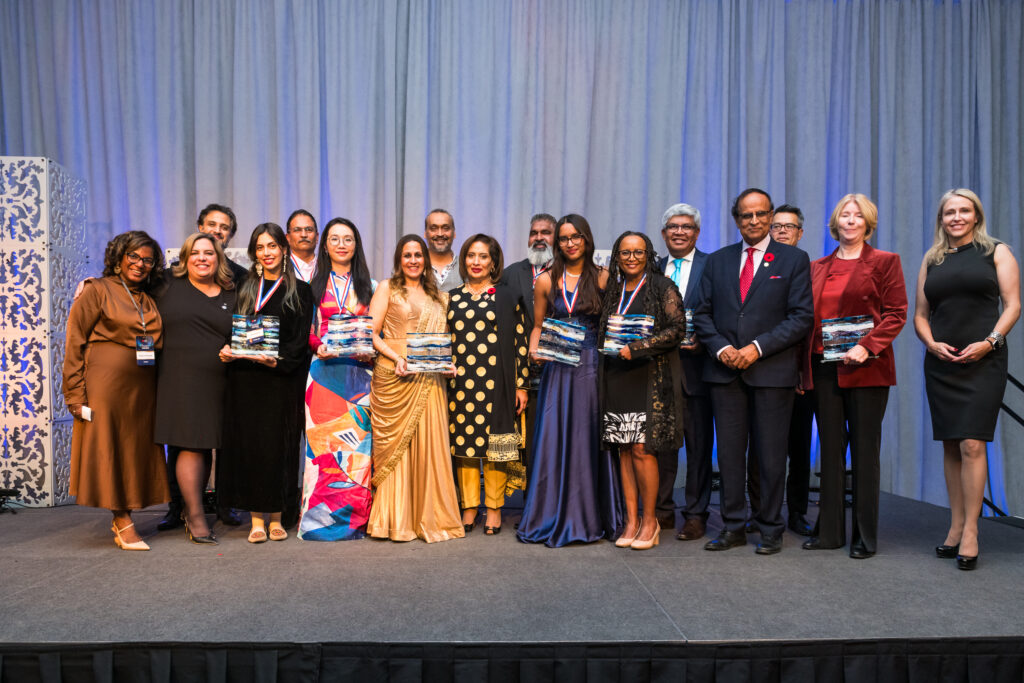Breaking Down the Myths about Immigrants in Canada
By Tihana Radojcic
Migration is as old as humankind. While most people migrate out of their choice, some migrate because they are forced to do so. Whether it is a quest for a better job, the desire to increase the standard of living, the unavoidable necessity to escape war, prosecution, or, more recently, climate-caused disasters, millions of people are on the move daily across the globe.

The current global estimate is that there were around 281 million international migrants in the world in 2020, which equates to 3.6 per cent of the global population. In Canada, around 500,000 new immigrants move to the country annually. This is the highest rate per population of any country in the world.
As of 2022, there were more than eight million immigrants with permanent residence living in Canada - roughly 20 percent of the total Canadian population. In addition to that, there were 963,400 work permit holders, over 800,000 international students, and 24,935 refugee claimants.
If these trends continue, based on Statistics Canada's population projections, immigrants could represent anywhere from 29.1 per cent to 34.0 per cent of the population of Canada by 2041.
And how does Canada welcome hundreds of thousands of newcomers? Well, that depends.
System of Support
When they first arrive in Canada, newcomers are looking for two major things: housing and employment. In a country with a 5.8 percent unemployment rate and 1.9 percent rental vacancy rate, this task quickly becomes an intimidating endeavor.

On top of that, language barriers, lack of credential recognition to find a job in the field, limited social connections, and overall adaptation to a new culture.
To support the system navigation, throughout the decades, the federal government in collaboration with provincial and municipal governments has established a solid and robust system of support that counts over 500 settlement organizations across the country. These organizations provide a variety of settlement services and have become a key part of Canada’s success in integrating immigrants.
But there is a catch.
Not all are Equal
International students, temporary migrant workers, and refugee claimants cannot access these services. Very often they have to rely on Google, social media channels, and limited social connections to find their way around.
The federal government estimates that international students contributed $21.6 billion to Canada's GDP in 2018—more than the export of auto parts, lumber, or aircraft. While international students are allowed to work during their studies, their work experience is not counted towards their application for permanent residency. This leaves a population of over eight hundred thousand in limbo.
Tens of thousands of migrant workers come to Canada each year on temporary permits to work in a range of sectors, from childcare, retail, hospitality, and planting and harvesting of fruits and vegetables to meat processing. Their work permits often do not extend beyond one year. Within that period, they cannot access to federally-funded settlement services.
Canada does not have systematic monitoring to ensure their rights are protected. Many are economically exploited, being charged illegal recruitment fees or being subjected to wage theft, and their visa conditions often make them dependent on their employers for such things as housing, access to healthcare, and access to basic information about their rights. Some workers who come to Canada under the Temporary Foreign Worker Program even become victims of human trafficking. Some say they face the threat of deportation or other retribution if they raise complaints.

Canada processed almost 60,000 applications from asylum seekers looking to take refuge in the country so far this year—the highest count in almost a decade. However, it is important to note that these numbers only reflect those who are successful in putting forth asylum claims through visa permits or UN channels, and not those who face barriers getting to the country.
The length of time to become a refugee after claiming asylum can range from months to years. As of June, the Immigration and Refugee Board had 103,987 refugee claims pending.
Due to the housing crisis in the country, asylum seekers oftentimes have no choice but to sleep on city streets due to a lack of support. Just as temporary migrant workers and international students, asylum seekers are also not eligible to access federally-funded services. This leaves them with limited options to seek support and successfully navigate the system.
Immigration Brand at Risk
Canada has committed to increasing immigrant admissions to 500,000 per year by 2025. A recent study found that about 7 in 10 Canadians support current—or increased—immigration levels.
Globally, Canada continuous to enjoy its brand as a top destination for immigrants. In fact, it is the most accepting country in the world for migrants. However, without addressing the previously mentioned challenges that almost two million immigrants face at any given time, Canada’s immigration brand could potentially be at risk.
This is more so true when we look at recent trends of immigrants leaving or planning to leave the country feeling disappointed and discouraged.
The federal government doesn't track migrant retention, but according to Statistics Canada, 50 per cent of international students had no tax records one year after graduation, suggesting they've left the country. Furthermore, 23 per cent of new Canadians and 30 per cent of new Canadians under 35 are considering leaving the country in the next two years.
The main reasons are unaffordable housing costs and lack of credential recognition that would enable meaningful employment and easier integration into society. Needless to say, immigrants are earning up to 20 percent less than born Canadians. For those whose credentials are not recognized it may take up to five years and tens of thousands of dollars to regain their professional status.
And yet, some blame immigrants for the housing and economic crisis.
Immigrants’ Contribution to Canadian Society
Here is just a snippet of how immigrants contribute to Canada:
- Immigration accounts for almost 100 per cent of Canada’s labour force growth.
- Canada’s population hit 40 million, and nearly all of last year's growth was due to immigration.
- Refugees who arrived in Canada as children have a higher completion rate of high school, college, university, and graduate degrees compared to children born in Canada.
- Immigrants account for 1 out of every 4 health-care sector workers in Canada: they make up 37 per cent of pharmacists, 36 per cent of physicians, 39 per cent of dentists, 23 per cent of registered nurses, and 35 per cent of nurse aides and related occupations.
- Immigrants make up 34 per cent of people working in scientific research and development services across Canada.
- Immigration is crucial to Canada's future. In 1971, Canada’s worker-to-retiree ratio was 7 to 1. By 2035, when 5 million Canadians are set to retire, the ratio will be down to 2 to 1.
And since we’re in Calgary, here’s a quick glance at immigrant contributions to our city:
- Immigrants account for one-third of the Calgary workforce.
- In Calgary, immigrants make up: More than 40 per cent of workers in the manufacturing sector, 64 per cent of workers in the food manufacturing sector, nearly 47 per cent of engineers, and more than 60 per cent of workers in transit and ground passenger transportation.
- Every 1,000 new immigrant families in Calgary with an average household income directly generate $84 million worth of new household expenditures.

International Migrants Day
Twenty-three years ago, the General Assembly of the United Nations proclaimed December 18th as International Migrants Day. The date was chosen because it was on this date in 1990 that the Assembly adopted the International Convention on the Protection of the Rights of All Migrant Workers and Members of their Families.
The UN did so due to the increasing number of migrants in the world. Ever since, the world has marked this day to raise awareness of the issues and challenges affecting migrants.
There are many ways in which you can take a pause and observe this day. The simplest act is to stop for a moment and think about what your country would be like without migrants. This is about the invisible work that is being done each day by migrant workers to ensures your family receives excellent healthcare support, you have access to reliable electricity and heating, your local transit runs smoothly, your packages get delivered on time, and that your coffee is brewed just the way you like it.
Find out what countries your ancestors came from. Maybe your colleague or a neighbour comes from the same country! If you know someone who has migrated to another country, ask them about their experience. Listen and learn from them.
Watch a movie or a documentary about migrants. Learn about famous migrants who helped build this country and who are still helping develop it.
Spread the word about the challenges immigrants are facing and take action to be part of the change.
Lois Patterson shares her experience of how she came to Canada in 1962 via the West Indian Domestic Scheme, in “Migrations,” the fourth episode of the CBC docuseries Black Life: Untold Stories.
About the Author
Tihana Radojcic moved to Calgary from her Croatian hometown of Zagreb in 2014 as a temporary foreign worker. She is a human rights activist and a freelance writer. She currently works as a manager at Immigrant Services Calgary.
Read More Newcomer Stories
- Meet Tamara: A mother’s fight – Immigrant Services Calgary
- Meet Olena: A Compassionate Interpreter for Ukrainian Newcomers in Calgary – Immigrant Services Calgary
- Tides are changing, but parades must keep marching – Immigrant Services Calgary
- Building capacity and creating connections: why volunteering is vital to non-profits and community – Immigrant Services Calgary
- A lifelong friendship: Nurturing connections on the path of immigration – Immigrant Services Calgary
- Immigrating to Calgary allowed me to be openly gay—but our city needs more spaces for LGBTQ+ Calgarians
- Meet Hanna: Escaping the war in Ukraine to find community in Calgary
- Dawari’s Journey: A Beacon of Hope for Newly Arrived Refugees in Calgary
💙Be inspired by the real-life journeys of newcomers
